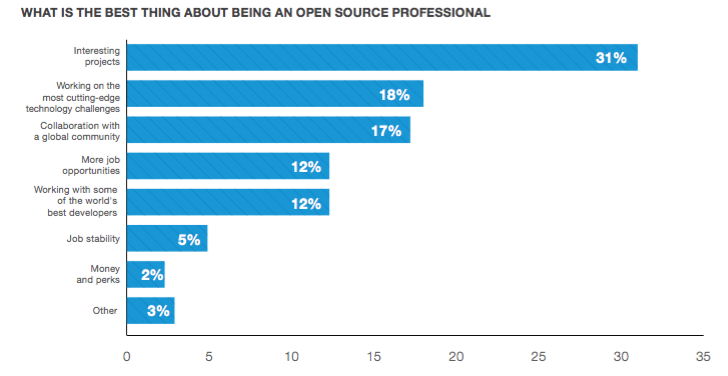If there’s one thing that unites those in the open-source community—besides a love of building and maintaining software—it’s their inclination to teach themselves what they need to know. According to the 2016 Open Source Jobs Report, created through a partnership between Dice and the Linux Foundation, some 90 percent of open-source professionals keep their skills up-to-date via the self-learning route, reading books and online resources whenever they have to learn something new. They’re also huge fans of online tutorials. (Some 4,500 people responded to the survey that provided the data for the report.) Roughly 60 percent have also taken online training courses, while another 45 percent said they attended conferences and events. Despite that tech-pro stereotype that everybody who generates code for a living is an introvert, those surveyed also indicated that they consulted frequently with others in order to increase their knowledge: some 42 percent engaged in social and professional networking, and nearly as many (35 percent) participated in open-source meet-ups. Meanwhile, nearly a quarter (23 percent) said they attended instructor-led open-source training. “Formal open-source training offers a level of depth and accuracy that piecemeal approaches can’t achieve,” the report stated, “and it is clear open source professionals are embracing training and certification developed by industry experts.” Next: What Drives Them (click here or below)
What Drives Them
Mastery of most open-source technologies takes a lot of time and effort. What motivates professionals to participate in the field? Some 31 percent of respondents said that “interesting projects” was the best part of being an open-source professional, while 18 percent cited the opportunity to work on cutting-edge technology challenges. The ability to collaborate with a global community came in third, with 17 percent. Meanwhile, roughly 12 percent of respondents said that more job opportunities was the best thing about participating in open source. The same percentage cited working with some of the “world’s best developers.” A mere 5 percent of respondents cited job stability, and 2 percent said money and perks. “It’s easy for open-source professionals to see how valuable they’ve become,” the report added. “Half of those surveyed were offered an incentive to keep them from switching jobs in the past year, while 73 percent were contacted by a recruiter at least once in the past six months.” Another 86 percent of respondents said that open-source skills had helped advance their careers. The Report makes one thing clear: the vast majority of open-source professionals are driven by passion rather than money. For younger tech pros debating which segments and disciplines they want to pursue, that promise of lifelong enthusiasm is a powerful attractant: if you’re going to spend the next thirty or forty years focusing on something, their reasoning might go, it better be something you love. Next: Breaking Into Open Source (click here or below)
Breaking Into Open Source
But how does one actually break into open source? There’s a reason why so many open-source professionals keep their skills up-to-date on their own, without the need for conferences or classes: the Web offers a ton of resources, as well as lots of experts willing to answer questions in forums. If you’re just starting out, check out opensource.com, which features a variety of tutorials, guides, and breakdowns of specific open-source projects, in addition to resources for beginners. Once you’ve learned a bit about open source, head over to SourceForge or GitHub and review any open projects that need contributors. (There’s also Freecode, but since it hasn’t been updated since mid-2014, some of the projects are quite stale.) A word about contributing: if you’re new to a project, start small. Squish a couple of bugs, test out some bits of code, but don’t step on any toes by attempting anything major until you’ve built up some equity with the project’s community. The great thing about open source is its collaborative nature. Show that you’re willing to help—even with administrative tasks such as documentation updating—and chances are good that you’ll be welcomed when you decide to tackle larger parts of a given project. Once you’ve learned a bit more about open source, you can also create your own project. Use Hacker News, Reddit, and other forums to highlight your work and request help. If you’re a student interested in open source, consider participating in the Google Summer of Code, a global program (103 countries and counting) that gives thousands of students the opportunity to write code and build projects during their summer break. For those looking for something a bit more specialized, internships and programs such as Tor Summer of Privacy, Mozilla Winter of Security, and the OpenDaylight Summer Internship focus on specific open-source categories as privacy and software-defined networking (SDN). Nor is open source a fad doomed to fade away in the next few years. Just take a look at the market-share for various industry segments. According to the Linux Foundation, 98 percent of the world’s supercomputers use Linux; roughly 75 percent of the servers powering the Web rely on Apache and Nginx, mostly running on Linux. As the Internet of Things comes online, Linux-based software is powering a growing ecosystem of devices wired to the Web. What does that mean for tech professionals just entering the industry, or those attempting to re-tool their careers by learning a new set of skills? Although the majority of open-source developers claim they don’t care as much about the money, the prevalence of Linux and similar platforms will likely ensure hefty salaries and job stability for some time to come.





